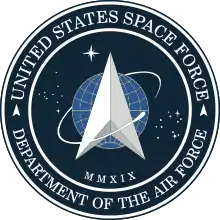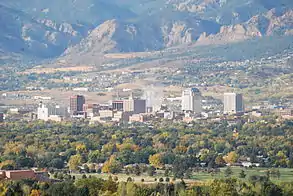Cheyenne Mountain Air Force Station
Cheyenne Mountain Air Force Station (CMAFS) is located on Cheyenne Mountain on the Front Range of the Rocky Mountains in unincorporated El Paso County, Colorado, USA, next to Colorado Springs,[1] The Cheyenne Mountain Complex, an underground facility on Cheyenne Mountain AFS, was first built for the North American Aerospace Defense Command (NORAD) Combat Operations Center, though NORAD moved day-to-day operations to its headquarters on Peterson AFB in 2006. However, day-to-day operations were moved back in 2011 after a major overhaul and renovation. The location now supports U.S. Space Command's Missile Warning Center, other strategic warning and survivable capabilities, and provides a ready alternative operating location for NORAD's command center.
| Cheyenne Mountain Air Force Station | |
|---|---|
| Near Colorado Springs, Colorado in the United States | |
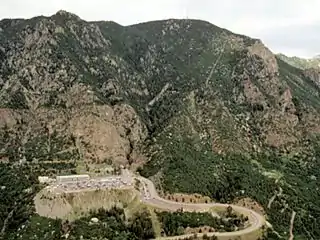 An aerial view of Cheyenne Mountain Air Force Station | |
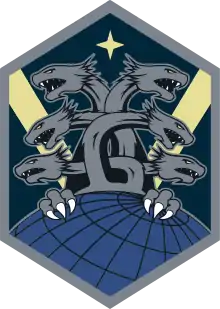 Shield of the Peterson-Schriever Garrison | |
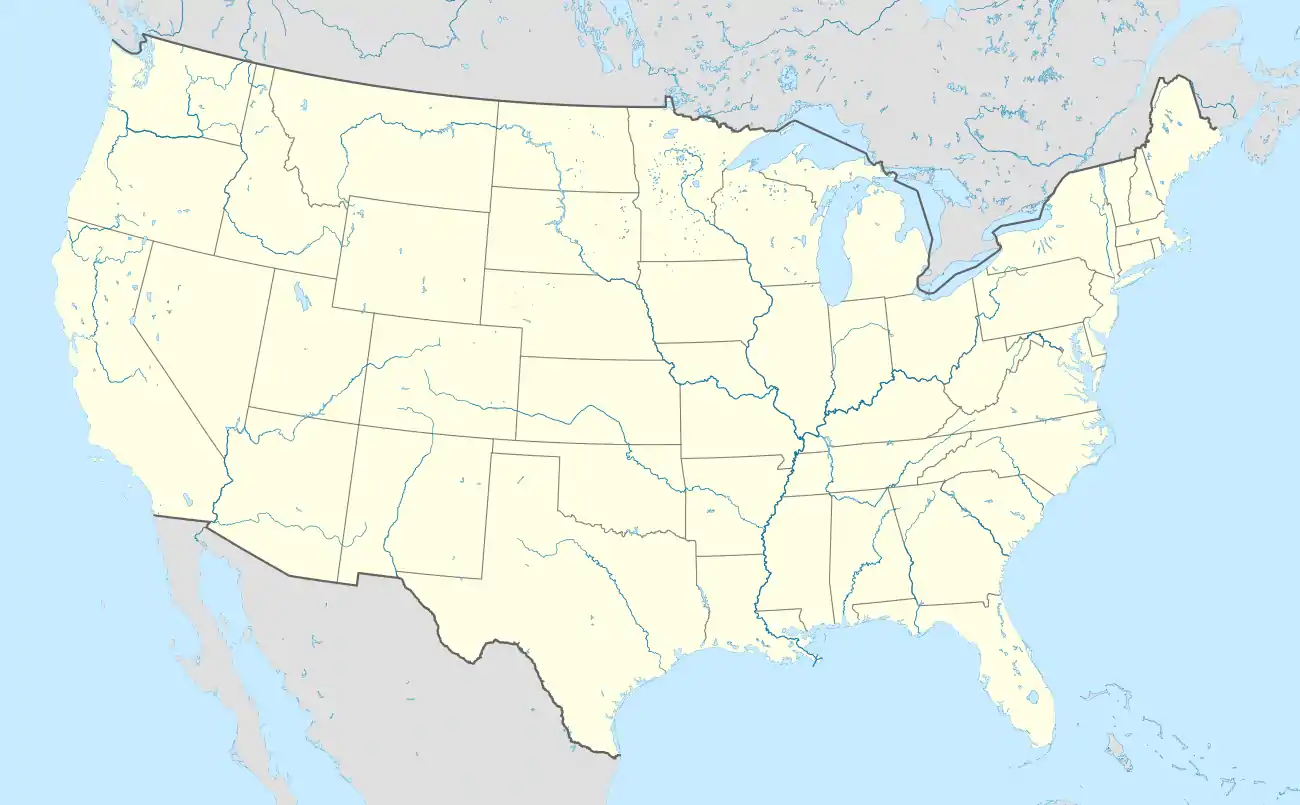 Cheyenne Mountain AFS Location in the United States | |
| Coordinates | 38°44′37.57″N 104°50′48.40″W |
| Type | United States Space Force |
| Site information | |
| Owner | Department of Defense |
| Operator | United States Space Force |
| Controlled by | Peterson-Schriever Garrison |
| Condition | Operational |
| Site history | |
| Built | 1961 – 1965 |
| Built by | US Army Corps of Engineers |
| In use | 1965 – present |
| Garrison information | |
| Occupants | NORAD Alternate Command Center |
Background
Until 2006, Cheyenne Mountain was the center for the United States Space Command and NORAD which monitored the air space of Canada and the United States through a worldwide system for early warnings of missiles, space systems, and foreign aircraft. The operations center was moved from an above-ground facility, vulnerable to missile or bomber attack, to the "granite shielded security" within Cheyenne Mountain during the Cold War as the Cheyenne Mountain Complex. The complex was built in the mid-1960s, began operations in 1966,[2][3] and NORAD's Combat Operation Center was fully operational on February 6, 1967.[4] Today the Air Force Station is used as a crew training center and is skeleton crewed and maintained as an alternate command center.[5] It has its own power plant, heating and cooling system, and water supply. The underground complex was built under 2,000 feet (610 m) of granite within five acres of excavated tunnels.[6] Structures outside of the military complex include the parking lots and roads, an old heliport,[7][lower-alpha 1] and the fire station.[8][lower-alpha 2] Outdoor facilities include Mountain Man Park, picnic areas, a racquetball facility, softball field, sand volleyball, basketball, a putting green, and horseshoes.[9] There is a fitness center inside and outside the mountain.[9] The portals for the blast tunnel are entered off the parking lot. The Air Force is responsible for all of NORAD Road, to Hwy 115, but has permitted local residents to access the road with motorized vehicles only per an easement agreement between the Air Force and City of Colorado Springs. A military gate limits NORAD Road usage past the residential turn-off just west of the State Highway 115 interchange.
The military complex has, in the past, included many units of NORAD, U.S. Space Command, Aerospace Defense Command, Air Force Systems Command, Air Weather Service, and the Federal Emergency Management Agency. The complex's communication center is also used by the nearby U.S. Civil Defense Warning Center.[2] The station has an exercise, weights, and cardio gym that is open 24 hours a day.[9]
United States Space Force units are under the command of the 21st Space Wing at Peterson Air Force Base.[10] Colorado Springs has a number of military installations. The others are Fort Carson, Peterson Air Force Base, the United States Air Force Academy.[3] and Schriever Air Force Base.
Air Force Space Command
The entire installation at Cheyenne Mountain was designated the Cheyenne Mountain Air Station by February 1995.[11] In 2000, the installation was renamed Cheyenne Mountain Air Force Station. That year all Air Force Space Command Air Stations in the United States have been redesignated as Air Force Stations.[12] At one time, the Air Force Station was the site of NORAD's Air Defense Operations Center.[13] That function, along with other day-to-day NORAD operational missions moved to the NORAD and USNORTHCOM headquarters building on Peterson Air Force Base.

Cheyenne Mountain Air Force Station is supported and operated by the 21st Space Wing, which is headquartered at Peterson Air Force Base and under the command of 14th Air Force and Air Force Space Command. In addition to supporting Peterson Air Force Base, the wing conducts operation space missions such as operating missile warning radar and cataloging objects in space for the U.S. Space Command. Those operational missions are managed by the 21st Operations Group.[14] The 21st Space Wing operates radar systems in the United States and worldwide, monitoring for launches of ballistic missiles and new space systems up to 22,300 miles (35,900 km) above the earth.[14] As of 2014, there are at least 20 countries able to launch long-range weapons, including chemical, biological, and nuclear weapons.[14] Cheyenne Mountain AFS force support and logistics services are provided by the 21st Mission Support Group at Peterson AFB. All other support such as equipment and facilities, including the Integrated Tactical Warning and Attack Assessment (ITW/AA) weapon system, are operated and maintained by the 721st Mission Support Group of the 21st Space Wing.[14][15] The 721 Mission Support Group is located at Cheyenne Mountain.[15] The 721st Civil Engineering Squadron operated from 1966. Under Col. Joseph Turk, 721st Mission Support Group Commander at the time, it was reactivated, reversing a 2004 action where its functions were outsourced. The last active duty commander was Lt. Col. Todd Wynn, who is now retired. It was re-activated on July 17, 2012, bringing some of the functions in-house under civilian employees. The civil engineering squadron is responsible for the engineering, maintenance, and operation of the complex.[6]
In 2006, the Space Control Center, the command and control hub for space surveillance in the United States, transferred its operations to the newly created Joint Space Operations Center (JSpOC) from Cheyenne Mountain Air Force Station. The JSpOC belongs to United States Strategic Command's Joint Functional Component for Space (JFCC SPACE); it is not part of NORAD or U.S. Northern Command. The Air Force Space Command support remained at the Cheyenne Mountain Air Force Station under the 21st Space Wing's 721st Mission Support Group.[16]
Global warning functions within the complex include the North American Aerospace Defense Command/U.S. Northern Command's Alternate Command Center, U.S. Strategic Command's Missile Warning Center, the 721st Global Strategic Warning/Space Surveillance System Center of the Integrated Tactical Warning/Attack Assessment system.[17]
The Missile Warning Center, a directorate under USSTRATCOM's JFCC Space, was upgraded in June 2011, upon completion of a $2.9 million project over 18 months. It was funded by USSTRATCOM and resulted in newer computers, more efficient workspace, a new knowledge visual display, new joint worldwide intelligence communication systems, and a new electronic procedural checklist.[18]
Tons of debris built up at the entrance to the Cheyenne Mountain Air Force Station following heavy rainfall and a resulting rock slide in September 2013. The 4th Infantry Division, with support by the 615th Engineer Company, 52nd Engineer Battalion, of Fort Carson cleared away the debris from a rockslide and uprooted trees. The storm and resulting debris did not limit the Air Force Station's operations, according to the 721st Mission Support Group's commander Col. Travis Harsha,[19] who became commander on July 11, 2013 for the now retired Col. Joseph Turk.[20]
On September 5, 2013, Cheyenne Mountain Air Force Station hosted an event with Federal Bureau of Investigation (FBI), local sheriffs and police chiefs, Army security forces, and Air Force security across several military installations about partnering for law enforcement and emergency management events, like terrorist threats, criminal activity, and forest fires. Partnering with law enforcement and the community helps to "foster information sharing and maximize joint training opportunities," according to Col. Travis Harsha, the CMAFS installation commander and 721st Mission Support Group Commander.[21]
On 20 December 2019, Air Force Space Command was redesignated as the U.S. Space Force and elevated to become an independent military branch.[22]
Cheyenne Mountain
The facility is adjacent to the Cheyenne Mountain State Park.[23] A telecommunication antenna farm is located on the highest point[3][24] and Pike National Forest is on the west side of the mountain.[3][25][26] The mountain is also the site of the Cheyenne Mountain Zoo and Will Rogers Shrine of the Sun.[3]
Notes
- The heliport is located off Norad Road, before the parking lot, at 38°44′29″N 104°50′03″W.[7]
- The fire station is located at 38°44′29″N 104°50′03″W.[8]
References
- "City Council Districts." Colorado Springs, Colorado. Retrieved on December 10, 2017. This shows the Cheyenne Mountain Air Force Station as outside the city limits.
- Joseph Angelo (31 October 2013). Dictionary of Space Technology. Routledge. p. 70. ISBN 978-1-135-94402-5.
- "From NORAD to Parks: A Tale of the Cheyenne Mountain Project" (PDF). Colorado Open Lands. Archived from the original (PDF) on February 1, 2015. Retrieved January 31, 2015.
- "Cheyenne Mountain Complex". NORAD. Retrieved February 19, 2015.
- "Cheyenne Mountain Air Force Station". www.norad.mil.
- Johnson, Lea (July 30, 2012). "721st MSG activates squadron, appoints leadership". Air Force Space Command. Retrieved July 3, 2016.
- "Cheyenne Mountain Heliport". Geographic Names Information System. United States Geological Survey. Retrieved 2012-07-25.
- "Cheyenne Mountain Air Force Station Fire Department". Geographic Names Information System. United States Geological Survey. Retrieved 2012-07-25.
- "Peterson Air Force Support Squadron: CMAFS". Peterson Air Force Base. Retrieved February 20, 2015.
- Joseph Angelo (31 October 2013). Dictionary of Space Technology. Routledge. p. 16. ISBN 978-1-135-94402-5.
- Orban, SSgt. Brian (February 1995). "The trip wire". Guardian. Air Force Space Command: 6.
missile warning center at Cheyenne Mountain AS
- "City". The Gazette. Colorado Springs, CO. February 5, 2000. Archived from the original on March 29, 2015. Retrieved February 19, 2015 – via HighBeam Research.
- Joseph Angelo (31 October 2013). Dictionary of Space Technology. Routledge. p. 276. ISBN 978-1-135-94402-5.
- "Fact Sheet: 21st Space Wing". Peterson Air Force Base. Retrieved February 20, 2015.
- "21st Space Wing: Units". Peterson Air Force Base. Retrieved February 20, 2015.
- "Media Advisory: Space unit to move from Cheyenne Mountain". September 15, 2006. Archived from the original on February 21, 2015. Retrieved February 20, 2015.
- "Cheyenne Mountain AFS visit". Peterson Air Force Base. July 23, 2013. Archived from the original on February 21, 2015. Retrieved February 20, 2015.
- "Cheyenne Mountain unveils renovated Missile Warning Center". Peterson Air Force Base. July 23, 2010. Archived from the original on February 21, 2015. Retrieved February 20, 2015.
- Staff Sgt. J. Aaron Breeden, 21st Space Wing Public Affairs (September 18, 2013). "Joint team clears flood debris from mountain entrance". Peterson Air Force Base. Archived from the original on February 20, 2015. Retrieved February 20, 2015.
- Staff Sgt. J. Aaron Breeden, 21st Space Wing Public Affairs (July 16, 2013). "Mountain gets new commander". Peterson Air Force Base. Archived from the original on February 21, 2015. Retrieved February 20, 2015.
- Michael Golembesky, 21st Space Wing Public Affairs staff writer (September 10, 2013). "Cheyenne Mountain builds upon partnership". Peterson Air Force Base. Archived from the original on February 20, 2015. Retrieved February 20, 2015.
- "Fact Sheet". www.spaceforce.mil.
- Maryann Gaug (March 23, 2010). "Cheyenne Mountain State Park". Best Hikes Near Denver and Boulder. Falcon Guides. p. 98. ISBN 978-0-7627-6223-1.
- Steven Saint (January 8, 2002). "The Springs' other mountain: There's a lot more to Cheyenne than NORAD". The Gazette. Colorado Springs. Archived from the original on March 29, 2015. Retrieved January 31, 2015 – via HighBeam Research.
- "Mount Big Chief (see upper right)" (PDF). National Forest Service. Retrieved February 2, 2015.
- "Cheyenne Mountain (see upper left)" (PDF). National Forest Service. Retrieved February 2, 2015.
Further reading
- Staff Sgt. J. Aaron Breeden, 21st Space Wing Public Affairs (June 11, 2013). "Mountain, man legacies intertwined". Peterson Air Force Base. Archived from the original on February 21, 2015.
- Michael Golembesky, 21st Space Wing Public Affairs staff writer (November 13, 2013). "Cheyenne Mountain firefighters recognized for valor". Peterson Air Force Base. Archived from the original on February 21, 2015.
External links
| External media | |
|---|---|
| Images | |
| Video | |
